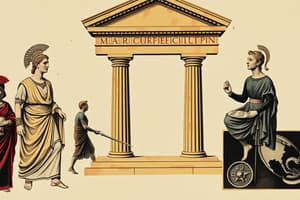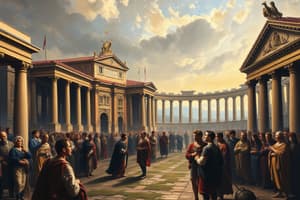Podcast
Questions and Answers
What is the name associated with the head of a Roman Patrician?
What is the name associated with the head of a Roman Patrician?
- Location
- Date
- Material
- Name (correct)
What is the date range for the head of a Roman Patrician?
What is the date range for the head of a Roman Patrician?
75 - 50 BC
Which period does the head of a Roman Patrician belong to?
Which period does the head of a Roman Patrician belong to?
Republican Roman
What is the location associated with the head of a Roman Patrician?
What is the location associated with the head of a Roman Patrician?
What material is the head of a Roman Patrician usually made of?
What material is the head of a Roman Patrician usually made of?
The function of the head of a Roman Patrician is described as a _____ sculpture that symbolizes virtues.
The function of the head of a Roman Patrician is described as a _____ sculpture that symbolizes virtues.
What context is provided for the busts of Roman patricians?
What context is provided for the busts of Roman patricians?
Match the descriptive terms to their correct characteristics:
Match the descriptive terms to their correct characteristics:
What look alike term is associated with the head of a Roman Patrician?
What look alike term is associated with the head of a Roman Patrician?
Flashcards are hidden until you start studying
Study Notes
Head of a Roman Patrician
- Represents a veristic style of sculpture, portraying realism and individuality.
- Crafted during the period of 75 - 50 BC in Republican Rome.
- The artwork is made of marble, a favored material for Roman sculptures.
- Serves as a symbol of virtues such as wisdom, determination, experience, valor, and strength revered by Roman Republicans.
- Busts of patricians highlight the importance of age and experience in Roman culture, showcasing wisdom attained through years.
- Currently housed in the Museo Torlonia, located in Rome, Italy.
- Key descriptive terms include elderly, veristic, bust, wisdom, experience, and realistic, emphasizing its detailed representation of the subject.
Studying That Suits You
Use AI to generate personalized quizzes and flashcards to suit your learning preferences.




